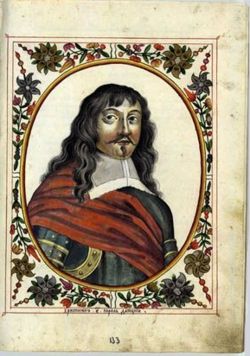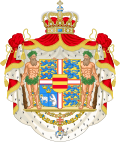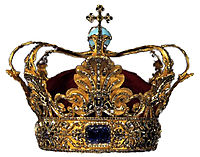- Christian V of Denmark
-
Christian V 
King of Denmark and Norway Reign 1670–1699 Predecessor Frederick III Successor Frederick IV Spouse Charlotte Amalie of Hesse-Kassel Issue Frederick IV of Denmark
Princess Sophia Hedwig
Prince Charles
Christian Gyldenløve
Ulrik Christian GyldenløveHouse House of Oldenburg Father Frederick III of Denmark Mother Sophie Amalie of Brunswick-Lüneburg Born 15 April 1646
Duborg Castle, FlensburgDied 25 August 1699 (aged 53)
CopenhagenBurial Roskilde Cathedral Religion Lutheranism Christian V (15 April 1646 – August 25, 1699), was king of Denmark and Norway from 1670 to 1699, the son of Frederick III of Denmark and Sophie Amalie of Brunswick-Lüneburg. He married Charlotte Amalie of Hesse-Kassel (or Hesse-Cassel) on 14 May 1667 at Nykøbing and ascended the throne on 9 February 1670.
Contents
Reign
It is generally argued that Christian V's personal courage and affability made him popular among the common people, but his image was marred by his unsuccessful attempt to regain Scania for Denmark in the Scanian War. The war exhausted Denmark's economic resources without securing any gains.[1]
Part of Christian's appeal to the common people may be explained by the fact that he allowed Danish commoners into state service, but his attempts to curtail the influence of the nobility also meant continuing his father's drive toward absolutism.[1][2] To accommodate non-aristocrats into state service, he created the new noble ranks of count and baron. One of the commoners elevated in this way by the king was Peder Schumacher, named Count Griffenfeldt by Christian V in 1670 and high councillor of Denmark in 1674.[1]
Griffenfeldt, a skilled statesman, better understood the precarious situation Denmark placed itself by attacking Sweden at a time when the country was allied with France, the major European power of the era. As Griffenfeldt predicted, Sweden's stronger ally France was the party that dictated the peace with Denmark's ally Holland, and in spite of Danish victory at sea in the battles against Sweden in 1675–1679 during the Scanian War, Danish hopes for border changes on the Scandinavian Peninsula between the two countries were dashed. The results of the war efforts proved politically and financially unremunerative for Denmark. The damage to the Danish economy was extensive. At this point, Christian V no longer had his most experienced foreign relations counsel around to repair the political damage - in 1676 he had been persuaded to sacrifice Griffenfeldt as a traitor, and to the clamour of his adversaries, Griffenfeldt was imprisoned for the remainder of his life.[3]
Christian V introduced Danske Lov (the Danish Code) in 1683, the first law code for all of Denmark.[4] It was succeeded by the similar Norske Lov (Norwegian Code) of 1687. He also introduced the land register of 1688, which attempted to work out the land value of the united monarchy in order to create a more just taxation. During his reign, science witnessed a golden age due to the work of the astronomer Ole Rømer in spite of the king’s personal lack of scientific knowledge and interest.
Like Charles XI of Sweden, who had never been outside Sweden, Christian spoke German and Danish only and was therefore often considered poorly educated due to his inability to communicate with visiting foreign diplomats.[5] Christian V was also often considered dependent on his councillors by contemporary sources. The Danish monarch did nothing to dispel this notion. In his memoirs, he listed "hunting, love-making, war and maritime affairs" as his main interests in life.[3]
He died from the after-effects of a hunting accident and was interred in Roskilde Cathedral.[3]
Personal life and family
 Portrait of Christian V in the old Russian reference book (1672)
Portrait of Christian V in the old Russian reference book (1672)
Christian V had eight children by his wife and five by his mistress. He publicly introduced his sixteen-year-old mistress, Sophie Amalie Moth (1654–1719), into court in 1672, a move which insulted his wife. His mistress was the daughter of his former tutor (Paul Moth), and he made her countess of Samsø on 31 December 1677.
Issue
Name Birth Death Frederick IV 2 October 1671 2 October 1730 Christian Vilhelm 1 December 1672 25 January 1673 Christian 25 March 1675 27 June 1695 Sophie Hedevig 28 August 1677 13 March 1735 Charles 26 October 1680 8 June 1729 Christiane Charlotte 17 July 1683 17 july 1683 Vilhelm 21 February 1687 23 November 1705 His children with his mistress, Sophie Amalie Moth;
Name Birth Death Christiane Gyldenløve 1672 1689 Christian Gyldenløve 28 February 1674 16 July 1703 Sophie Christiane Gyldenløve 1675 18 August 1684 Anna Christiane Gyldenløve 1676 11 August 1689 Ulrik Christian Gyldenløve 24 June 1678 8 December 1719 After the Scanian War, his sister, Princess Ulrike Eleonora of Denmark, married the Swedish king Charles XI, whose mother was a stout supporter of the Duke of Holstein-Gottorp. In spite of the family ties, war between the brothers-in-law was close again in 1689, when Charles XI nearly provoked confrontation with Denmark by his support of the exiled Christian Albert, Duke of Holstein-Gottorp in his claims to Holstein-Gottorp in Schleswig-Holstein.[5]
Ancestry
References
- ^ a b c "Christian V." (2007). In Encyclopædia Britannica. Retrieved 9 January 2007, from Encyclopædia Britannica Online.
- ^ Jespersen, Knud J.V. The Introduction of Absolutism. Gyldendal Leksikon, quoted by The Ministry of Foreign Affairs of Denmark, on Denmark's official web site.
- ^ a b c Nielsen, Kay Søren (1999). Christian V - Konge og sportsmand. The Royal Danish Arsenal Museum, Net Publications, 1999.
- ^ Jespersen, Knud J.V. Denmark as a Modern Bureaucracy. Gyldendal Leksikon, quoted by The Ministry of Foreign Affairs of Denmark, on Denmark's official web site.
- ^ a b Upton, Anthony F. (1998). Charles XI and Swedish Absolutism, 1660–1697. Cambridge University Press, 1998. ISBN 0-521-57390-4.
External links
- The Royal Orders of Chivalry (Order of Dannebrog, instituted by Christian V in 1671) — Official site of the Danish Monarchy
- Find-A-Grave entry for Christian V
- Nielsen, Kay Søren. "Christian V. Konge og sportsmand" (in Danish). The Royal Danish Arsenal Museum. http://www.thm.dk/publ/ksn/ksn1_1.htm. Retrieved 29 November 2009.
Christian VBorn: 14 April 1646 Died: 25 August 1699Regnal titles Preceded by
Frederick IIIKing of Denmark and Norway
Count of Oldenburg
1670–1699Succeeded by
Frederick IVPreceded by
Frederick III and
Christian AlbertDuke of Holstein and Schleswig
1670–1699
with Christian Albert (1670-1695)
Frederick IV (1695-1699)Succeeded by
Frederick IV (Denmark)
and
Frederick IV (Gottorp)Monarchs of Denmark Early monarchs c.916–1412(Harthacnut) · Gorm the Old · Harald Bluetooth · Sweyn Forkbeard1 · Harald II · Cnut the Great1 · Harthacanute1 · Magnus the Good · Sweyn II · Harald III · Canute the Saint · Olaf I · Eric Evergood · Niels · Eric the Memorable · Eric Lamb · Sweyn Grathe / Canute V / Valdemar the Great · Canute VI · Valdemar the Victorious / Valdemar the Young · Eric Plough-tax · Abel · Christopher I · Eric Klipping · Eric Menved · Christopher II · Valdemar III · Christopher II · Interregnum · Valdemar Atterdag · Olaf II · Margaret I2
Palatinate-Neumarkt 1397–1448Oldenburg 1448–1863Christian I2 · John2 · Christian II2 · Frederick I · Christian III · Frederick II · Christian IV · Frederick III · Christian V · Frederick IV · Christian VI · Frederick V · Christian VII · Frederick VI · Christian VIII · Frederick VIISchleswig-Holstein-
Sonderburg-Glücksburgsince 1863Monarchs of Norway Fairhair dynasty · rival
rulers of other housesHarald I Fairhair · Eric Bloodaxe · Haakon I the Good · Harald II Greycloak · Haakon Sigurdsson 1 · Olaf I Tryggvason · Eiríkr Hákonarson 1 & Sveinn Hákonarson 1 & Hákon Eiríksson 1 · Sweyn Forkbeard · Olaf II the Saint · Hákon Eiríksson 1 · Canute the Great · Sveinn Álfífuson 1 · Magnus I the Good · Harald III Hardrada · Magnus II Haraldsson · Olaf III Kyrre · Haakon Magnusson & Magnus III Barefoot · Olaf Magnusson · Eystein I Magnusson · Sigurd I the Crusader · Magnus IV the Blind · Harald IV Gille · Sigurd the Noisy · Sigurd II Munn · Eystein II Haraldsson · Inge I Haraldsson the Hunchback · Haakon II Broadshoulder · Magnus Erlingsson · Sigurd Markusfostre · Olav the Unlucky · Eystein the Maiden · Sverre Sigurdsson · Jon Kuvlung · Sigurd Magnusson · Inge Magnusson · Haakon III Sverresson · Guttorm Sigurdsson · Inge II Bårdsson · Erling Stonewall · Philip Simonsson · Haakon IV Haakonsson · Haakon the Young · Magnus VI the Law-mender · Eric II Magnusson · Haakon V MagnussonKnýtlinga 985–995
1028–1035Fairhair dynasty · Sweyn Forkbeard 5 · Fairhair dynasty · Canute the Great 5 · Sweyn Knutsson 2 Fairhair dynastyBjelbo 1319–1387The Kalmar union 1387–1448Oldenburg 1448–1814Christian I 4 · John 4 · Christian II 4 · Frederick I 2 · Christian III 2 · Frederick II 2 · Christian IV 2 · Frederick III 2 · Christian V 2 · Frederick IV 2 · Christian VI 2 · Frederick V 2 · Christian VII 2 · Frederick VI 2 · Christian FrederickHolstein-Gottorp
Bernadotte1814–1905Schleswig-Holstein-
Sonderburg-Glücksburgsince 19051 Regent. 2 Also Danish monarch. 3 Also Swedish monarch. 4 Also Danish and Swedish monarch.5 Also Danish and English monarch.Categories:- Counts of Oldenburg
- 1646 births
- 1699 deaths
- People from Flensburg
- Danish monarchs
- Norwegian monarchs
- Dukes of Schleswig
- Dukes of Holstein
- House of Oldenburg
- Denmark–Norway
- Protestant monarchs
- Knights of the Garter
- Burials at Roskilde Cathedral
- Accidental deaths in Denmark
- Hunting accident deaths
Wikimedia Foundation. 2010.

